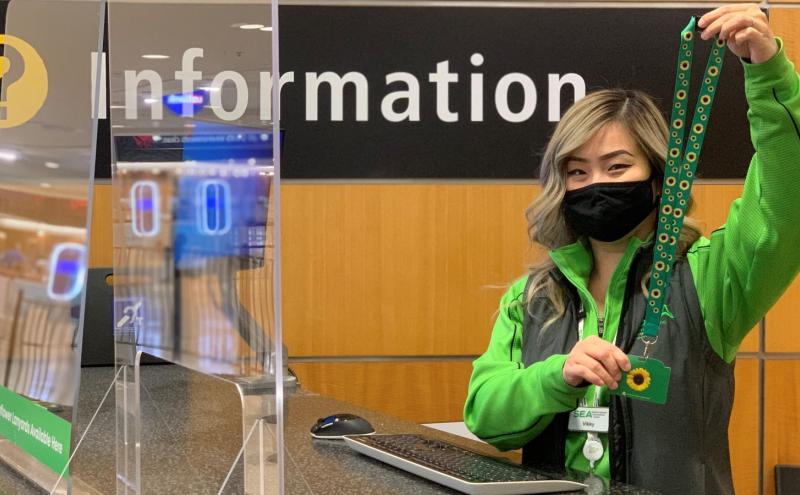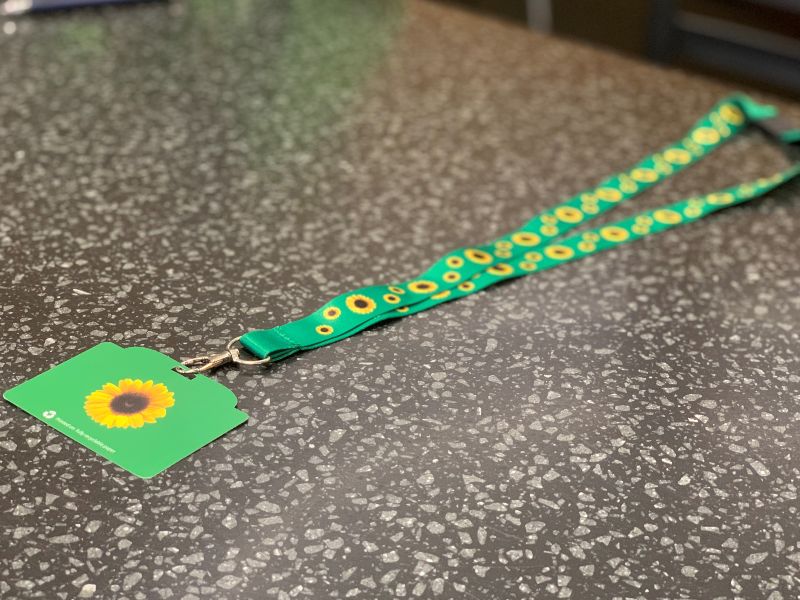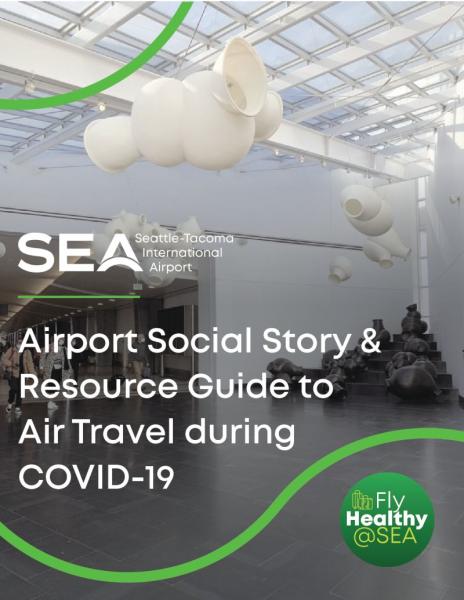
It’s easy for airport employees to lend a hand to travelers with visible cues of a disability like a passenger in a wheelchair. But there are other “hidden disabilities” that are less apparent such as autism, Crohn’s disease, dementia, hearing impairment, multiple sclerosis, and PTSD. According to the Centers for Disease Control (CDC), 26 percent of American adults have some type of disability, many of them not visually apparent. SEA Travelers with hidden disabilities may request a sunflower lanyard to let airport staff know that they may need a little help or extra patience.
 To better meet the needs of all travelers with disabilities, SEA Airport celebrated our one-year anniversary of the Sunflower Lanyard program on October 23. This program was pioneered by Gatwick Airport in Great Britain, and SEA became the first airport in the United States to implement the Sunflower Lanyard program. In the first year of the program, we have distributed hundreds of lanyards and seen expansion to other U.S. airports.
To better meet the needs of all travelers with disabilities, SEA Airport celebrated our one-year anniversary of the Sunflower Lanyard program on October 23. This program was pioneered by Gatwick Airport in Great Britain, and SEA became the first airport in the United States to implement the Sunflower Lanyard program. In the first year of the program, we have distributed hundreds of lanyards and seen expansion to other U.S. airports.
Sunflowers grow around the world
Sunflower lanyards are now offered at more than 30 airports across the globe, with more to come in 2021.
- View a map of participating airports
At SEA, travelers benefit from increased awareness of their needs by wearing the optional sunflower lanyard. Airport Pathfinders, customer service staff, volunteers, and the airport community know that a traveler wearing the lanyard may need additional support. Depending on the situation, our team can tailor their customer service approach. Whether it’s pointing the traveler towards airport amenities or demonstrating extra patience, our goal is for all travelers with disabilities to have a positive experience at the airport and get the support you need.
Pathfinder Ghulam Mohmand shares that the lanyards are “very positive and (a) good step for taking care of our customers at SEA.” Pathfinder Amadou Ly adds “It is a really good vibe we get from the passengers … It has a good impact.”
We have heard on social media that our travelers love this program.
- “Love this program to support travelers with #Autism and other #invisibledisabilities”
- “I’m grateful for SeaTac sunflower program”
- “Little things like this make travel easier for ALL involved!”
Making travel easier and improving the overall airport experience is our goal. And, picking up a lanyard is easy as well. They are offered complimentary at SEA Airport at the Main Information Desk, located between checkpoint 3 and 4.
As Ly explains, customers “see us in our green uniform and ask for a lanyard. And, we ask if there is anything else we can do to help.”
Travelers should continue to coordinate with their airlines and/or TSA Cares for pre-travel questions and accommodation arrangements.
Step by step guide to travel at SEA
 We are excited to expand our offerings for passengers with hidden disabilities, including travelers with autism. Working with external stakeholders from the Arc of King County and Washington Autism Alliance & Advocacy, we recently created a Social Story & Resource Guide. Designed for travelers with autism, it can be used by anyone who wants to know what to expect before coming to the airport.
We are excited to expand our offerings for passengers with hidden disabilities, including travelers with autism. Working with external stakeholders from the Arc of King County and Washington Autism Alliance & Advocacy, we recently created a Social Story & Resource Guide. Designed for travelers with autism, it can be used by anyone who wants to know what to expect before coming to the airport.
The 52-page PDF, in a storybook format, can be printed at home or viewed on a device and is designed to be reviewed before travel. It details the SEA airport travel experience with an emphasis on COVID-19 health and safety measures and includes sections on:
- Getting to the airport
- Finding my gate
- Riding the train
- Boarding my flight
- Collecting my bags
For every step, the document includes current photos and simple sentences that will clarify what a traveler can expect and highlights any possible sensory triggers, such as loud noises and flashing lights.
Like a “choose your own adventure” book, you can skip sections that do not apply. The resources section also includes maps, web links, COVID-19 signage travelers will see in the airport, and Sensory and Environment Icons for those who use PEC boards.
COVID-19 has dramatically altered virtually every aspect of our lives. Travel is no different. We hope that this Social Story & Resource Guide will help travelers and their caregivers get ready for travel during a world of mask wearing and physical distancing.
Moving forward
As we reflect on this first year of sunflower lanyard participation and the launch of a new resource, we are committed to expanding accessibility services to our travelers. Here are a few more resources to make your journey better.
Sensory Room
In the near future, we will be opening SEA’s first sensory room to address the needs of passengers with autism, sensory processing disorders, or those who need respite from the many sights and sounds of the airport. Check the SEA Airport App or ask a Pathfinder in green on your next visit.
SEA Airport App
At SEA, our goal is to be the most accessible airport in the country, so we’re building numerous services to help you navigate the airport. Another tool is the SEA Airport App that provides information on accessibility services at the airport. By clicking the accessibility button on the home page, you will find information on getting a wheelchair in the terminal, using hearing loop and Aira services, and how to get a lanyard for travelers with hidden disabilities.
Assistive technology for travelers with low vision
- Learn about Aira, a cell-phone-based tool to help travelers with low vision navigate the airport






